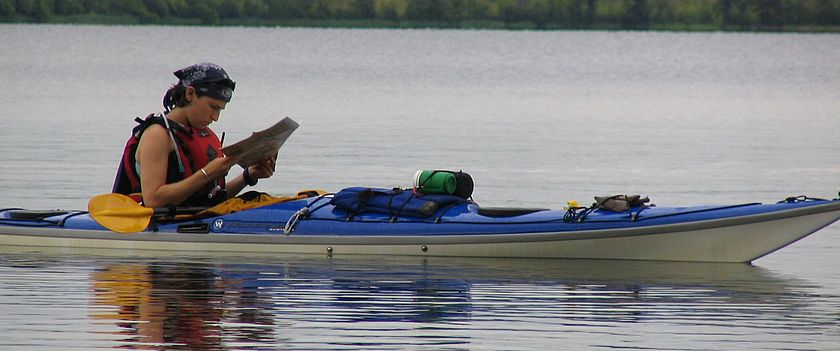
Planning a Safe Trip
Boating on the lake can be a wonderful experience if you are well prepared and use common sense. Changing weather, variable water conditions, and other activity on the lake can affect your safety and enjoyment. Please follow these guidelines while traveling on the Trail.
Stay within your abilities
While many may dream of paddling Lake Champlain end to end in a week, it’s beyond most of our abilities. Your paddling experience will be more enjoyable and safer if you know your limits and the limits of everyone in your group and stay within them. Pay attention to the weather and let it guide your itinerary rather than forcing yourself into dangerous situations just to stay on an arbitrary schedule. If your trip involves open-water lake crossings, remember that open waters have larger waves than protected shorelines. On windy days, stay along the shore.
File a Float Plan
Always file a float plan with a reliable friend or family member on land whether you’re heading out for a day trip or an extended journey. Keep that person informed of changes to your itinerary. The float plan should include:
- Anticipated itinerary: put in, take out, and planned stops or camping destinations, and when you expect to return.
- Back up plans for inclement weather or other emergencies.
- Emergency contact information.
- For longer trips: regular check points where you’ll call from upon arrival.
Respect the Weather
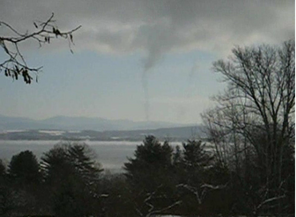
Weather may make the biggest difference between a calm pleasant paddle and a life-threatening adventure. Weather on Lake Champlain can change dramatically and with surprising speed. Some of the most harrowing tales from Lake Champlain come from people who went out for a quick day trip and got caught in an unanticipated storm. Know and understand the present and forecast conditions. Check the Lake Champlain graphical forecast regularly. In particular, paddlers should be prepared for the dangers of:
Cold Water – Cold water immersion and hypothermia present the greatest single danger to paddlers. Dress for water temperatures, not air temperatures. Water temperatures less than 70 degrees F. cause you to lose precious body heat up to 25 times faster than comparable air temperatures. In many areas of the lake, especially the main lake, water temperatures may never reach 70 degrees F. Since small people lose body heat faster than larger people, children are at particular risk. As your core body temperature drops, your muscles stop functioning and you eventually lose consciousness. To prepare for cold water paddling:
- Wear a wetsuit or drysuit with an insulating layer.
- Wear gloves and a hat.
- Do not paddle alone.
The Effects of Hypothermia in Cold Water
| Water Temperature (Degrees F.) | Exhaustion or Unconsciousness | Expected time of Survival |
|---|---|---|
| 32.5 | Under 15 minutes | Under 15 to 45 minutes |
| 32.5 to 40 | 15 to 30 minutes | 30 to 90 minutes |
| 40 to 50 | 30 to 60 minutes | 1 to 3 hours |
| 50 to 60 | 1 to 2 hours | 1 to 6 hours |
| 60 - 70 | 2 to 7 hours | 2 to 40 hours |
| 70 to 80 | 2 to 12 hours | 3 hours to indefinite |
Wind and Waves – Whitecaps are a clear sign of dangerous conditions on the lake. Waves can overturn your boat (especially canoes), make it difficult to turn, prevent you from holding course, and slow or stop your progress. Wave conditions can be especially chaotic and dangerous in shallows and along shoals, cliffs and rock bluffs. Waves in open water can be much higher than those in protected coves or behind islands.
Thunder and Lightning – When thunderstorms are forecast, stay off the water. When thunderstorms approach, get off the water.
Fog – Fog can result in total disorientation. In foggy conditions use compass, steady wind, and wave direction or sounds such as a foghorn or crashing waves to orient yourself.
Be Well-equipped
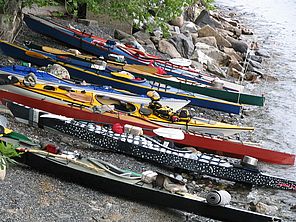
Plan ahead for your water adventures whether they are short outings, day-long excursions, or overnight trips. Be sure everyone in your party is well-equipped. Use the checklist in Appendix A, page 96, as a guide.
Bring nautical charts and compass - Always carry a nautical chart and compass and know how to use them. Charts help you navigate on the lake and chart your course. They show land masses, buoys, lighted marks, depth readings and other location devices. Mileage information on charts is described in nautical miles rather than land miles. (One nautical mile corresponds to one minute of latitude and is 1.15 land miles. A nautical mile is 6,076 feet as opposed to 5,280 feet of a land mile.) Charts are always oriented true north, depicted on the outside scale of the printed compass rose. When navigating by a handheld or boat compass, use the inner, magnetic circle.
Carry a VHF radio and cell phone – VHF radios and cell phones are valuable tools to stay abreast of weather conditions and communicate with shore and other vessels. Regularly check the weather forecast. In an emergency, contact the Coast Guard or other boats using channel 16 on your VHF.
Bring emergency supplies – Pack an audible signal (whistle or horn) and a visual signal (at least three flares), and a waterproof flashlight or headlamp for emergency situations.
Bring Drinking Water - Potable water isn’t available at all sites. Bring extra water and a water filter with you to stay hydrated. Filter all water sources other than those that are designated as potable. Bring food to keep your energy up.
Wear a Personal Flotation Device (PFD) – Use a Coast Guard approved PFD. Prior to heading out, check your PFDs for tears and holes and to ensure that the seams, fabric straps and hardware are in good condition. There should be no signs of waterlogging or shrinkage of the buoyant materials. Trial test your PFD in shallow water. To check for buoyancy, relax your body and let your head tilt back. Your PFD should keep your chin above water and allow you to breathe easily. If your mouth is not well above water, replace your PFD with one with more buoyancy.
Watch for Other Boats
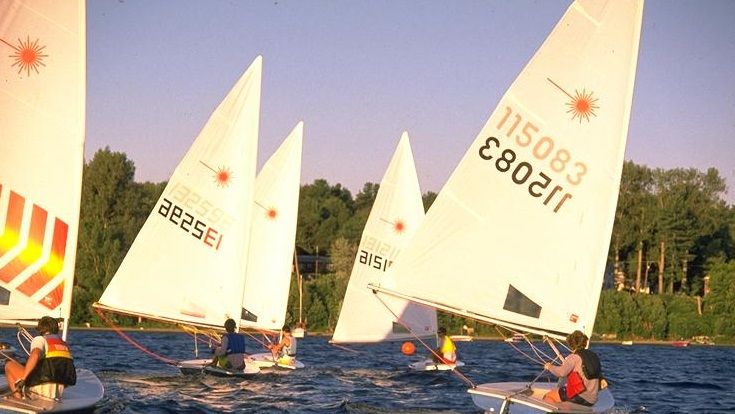
Watch for powerboats, ferries and other watercraft. Strive to make yourself visible but assume that large boats often cannot see smaller vessels in the water or maneuver quickly enough to avoid a collision. Large boats generally appear to be traveling slower than they actually are and often generate dangerous wakes. Paddlers should avoid ferry lanes. Groups should keep together so other boaters do not have to steer around too many separate kayaks or canoes.
Prepare for Water Hazards
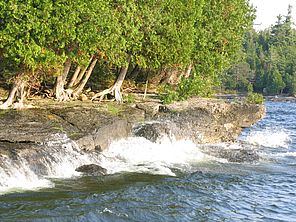
Many hazards can lurk in the water. Partially submerged logs and other matter present navigation challenges. Keep a watchful eye out and avoid flotsam. Zebra mussels, sharp rocks and broken glass can cut your feet. Algae may coat rocks and launch ramps and make footing slippery, especially when carrying boats. Always wear boat shoes of some sort when wading and try to carry boats as a team.
